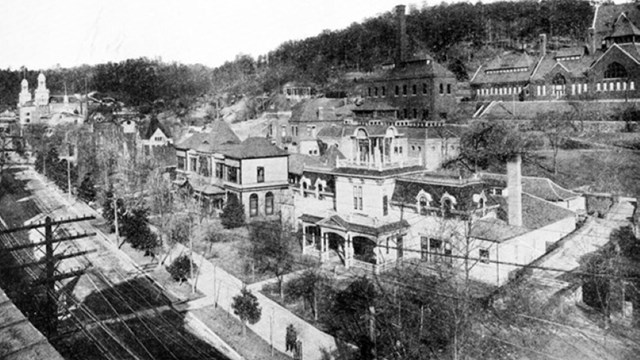
NPS photo, HOSP archives The History of Bathhouse RowThe first bathhouses were crude structures of canvas and lumber, little more than tents perched over individual springs or reservoirs carved out of the rock. Later, businessmen built wooden structures, but they frequently burned, collapsed because of shoddy construction, or rotted due to continued exposure to high temperatures and humidity. As the bathhouses continued to grow in popularity, the park's superintendent deemed that more resilient and fireproof structures were needed. Starting in 1896, many of the wooden bathhouses were replaced with the bathhouses that we see today made of masonry and steel. Hot Springs CreekHot Springs Creek, which ran right in front of all the bathhouses, drained its own watershed and collected the runoff of all the springs until the late 1880s. As Hot Springs Reservation grew in popularity and population, it became an eyesore due to pollution. The creek was also dangerous at times of high water and certain areas of the creek became mere collections of stagnant pools at dry times. 
Labeled: HOT SPRINGS NATIONAL PARK, ARK. THE WORLD'S SANITARIUM IN 1875 Hot Springs Creek & Early Bathhouses In 1882-83 the government enclosed Hot Springs creek in an underground arch for flood and sewerage control. The arch was then covered with earth, and the area above it was landscaped to create a pleasing park bounded with Lombardy poplars. This allowed room for landscaping in front of the bathhouses, creating the Bathhouse Row and you see today.The new Victorian bathhouses built between 1880 and 1888 were larger and more luxurious than could have been dreamed of ten years earlier. The haphazardly placed wooden troughs carrying the thermal water down the mountainside were replaced with underground pipes. Roads and paths were improved for the convenience of visitors who wished to enjoy the scenery. 
NPS Photo/HOSP The Decline of the Bathing IndustryBy the 1960s the bathing industry in the park and in the city had declined considerably. On Bathhouse Row, the eight grand bathhouses that had been thriving since their construction in the first three decades of the century suffered from the decline. The elegant Fordyce Bathhouse was the first to close, in 1962, followed by the Maurice, the Ozark, and the Hale in the 1970s. In 1984 the Quapaw (briefly reincarnated as Health Services, Inc.) and the Superior closed. When the Lamar closed in 1985, it left only the Buckstaff still operating on Bathhouse Row. Bathhouse Row and its environs were placed on the National Register of Historic Places on November 13, 1974. The desire to revitalize Bathhouse Row also led citizens to campaign for adaptive uses of the vacant buildings. The strongest concern was to save the most elegant bathhouse, the Fordyce, which was consequently adapted for use as the Hot Springs National Park visitor center and museum. At this point in time most of the bathhouses have been renovated and adapted for modern use. Useful Facts about the Historic Buildings on Bathhouse Row
* Organized by the Horse Shoe-Magnesia Bathhouse Corp. and originally called Platt Bathhouse.; renamed in 1922 **Reopened as Health Services, Inc., in 1969, then closed for good in 1984 
Bathhouses of Hot Springs
Delve into the history, economics, and environmental considerations that led to the creation of Bathhouse Row. 
Soak in the Springs
Fully submerge yourself in the thermal water and let your worries melt away. 
Places
Learn about the historical places in the Park. Read more about Bathhouse Row |
Last updated: April 29, 2022
